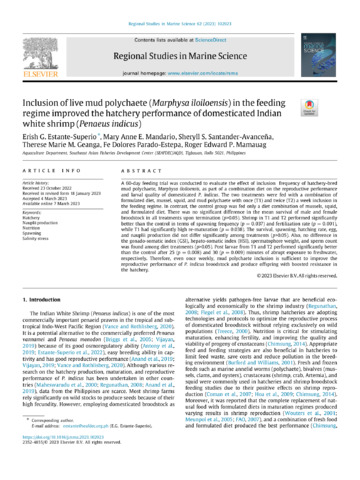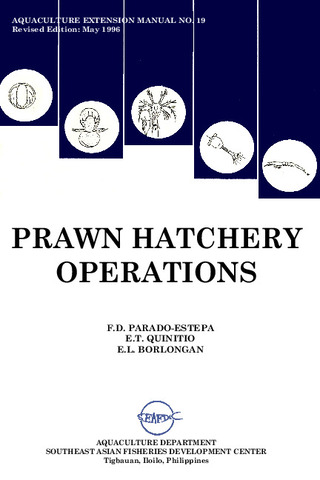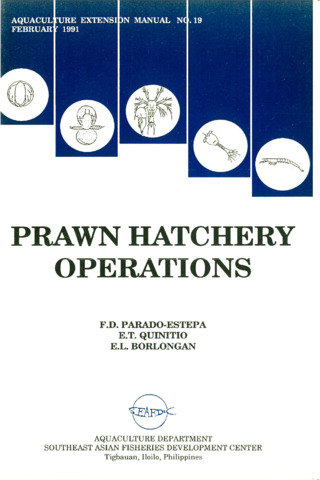Inclusion of live mud polychaete (Marphysa iloiloensis) in the feeding regime improved the hatchery performance of domesticated Indian white shrimp (Penaeus indicus)
- Global styles
- MLA
- Vancouver
- Elsevier - Harvard
- APA
- Help

View/
Date
2023-03-07Author
Page views
1,044ASFA keyword
AGROVOC keyword
Taxonomic term
Metadata
Show full item record
Share
Abstract
A 60-day feeding trial was conducted to evaluate the effect of inclusion frequency of hatchery-bred mud polychaete, Marphysa iloiloensis, as part of a combination diet on the reproductive performance and larval quality of domesticated P. indicus. The two treatments were fed with a combination of formulated diet, mussel, squid, and mud polychaete with once (T1) and twice (T2) a week inclusion in the feeding regime. In contrast, the control group was fed only a diet combination of mussels, squid, and formulated diet. There was no significant difference in the mean survival of male and female broodstock in all treatments upon termination (\(p\gt0.05)\). Shrimp in T1 and T2 performed significantly better than the control in terms of spawning frequency (\(p=0.037)\) and fertilization rate (\(p=0.001)\), while T1 had significantly high re-maturation (\(p=0.038)\). The survival, spawning, hatching rate, egg, and nauplii production did not differ significantly among treatments (\(p\gt0.05)\). Also, no difference in the gonado-somatic index (GSI), hepato-somatic index (HSI), spermatophore weight, and sperm count was found among diet treatments (\(p\gt0.05)\). Post larvae from T1 and T2 performed significantly better than the control after 25 (\(p=0.008)\) and 30 (\(p=0.009)\) minutes of abrupt exposure to freshwater, respectively. Therefore, even once weekly, mud polychaete inclusion is sufficient to improve the reproductive performance of P. indicus broodstock and produce offspring with boosted resistance in the hatchery.
Suggested Citation
Estante-Superio, E., Mandario, M. A., Santander-Avancena, S., Geanga, T. M. M., Estepa, F. D., & Mamauag, R. E. (2023). Inclusion of live mud polychaete (Marphysa iloiloensis) in the feeding regime improved the hatchery performance of domesticated Indian white shrimp (Penaeus indicus). Regional Studies in Marine Science , 62, 102923. https://doi.org/10.1016/j.rsma.2023.102923
Type
ArticleISSN
2352-4855Collections
- Journal Articles [1258]
Related items
Showing items related by title, author, creator and subject.
-
Series: Aquaculture extension manual; No. 19
Prawn hatchery operations
Parado-Estepa, Fe D.; Quinitio, Emilia T. ; Borlongan, Emeterio L. (Aquaculture Department, Southeast Asian Fisheries Development Center, 1996-05)
The manual, an updated version of the 1984 SEAFDEC/AQD manual, presents the underlying principles and step-by-step instructions of prawn larval and post-larval rearing. The techniques described are not only applicable to ...
; Borlongan, Emeterio L. (Aquaculture Department, Southeast Asian Fisheries Development Center, 1996-05)
The manual, an updated version of the 1984 SEAFDEC/AQD manual, presents the underlying principles and step-by-step instructions of prawn larval and post-larval rearing. The techniques described are not only applicable to ... -
Series: Aquaculture extension manual; No. 19
Prawn hatchery operations
Parado-Estepa, Fe D.; Quinitio, Emilia T. ; Borlongan, Emeterio L. (Aquaculture Department, Southeast Asian Fisheries Development Center, 1991-02)
The manual, an updated version of the 1984 SEAFDEC/AQD manual, presents the underlying principles and step-by-step instructions of prawn larval and post-larval rearing. The techniques described are not only applicable to ...
; Borlongan, Emeterio L. (Aquaculture Department, Southeast Asian Fisheries Development Center, 1991-02)
The manual, an updated version of the 1984 SEAFDEC/AQD manual, presents the underlying principles and step-by-step instructions of prawn larval and post-larval rearing. The techniques described are not only applicable to ... -
Evaluation of plant proteins as partial replacement for animal proteins in diets for Penaeus indicus and P. merguiensis juveniles
Peñaflorida, Veronica D. (Society of Israeli Aquaculture and Marine Biotechnology, 2002)The growth rate and survival of two white shrimps, Penaeus indicus and P. merguiensis, fed diets in which fishmeal was partially replaced with plant protein sources were investigated in three trials. In trial 1 with P. ...





